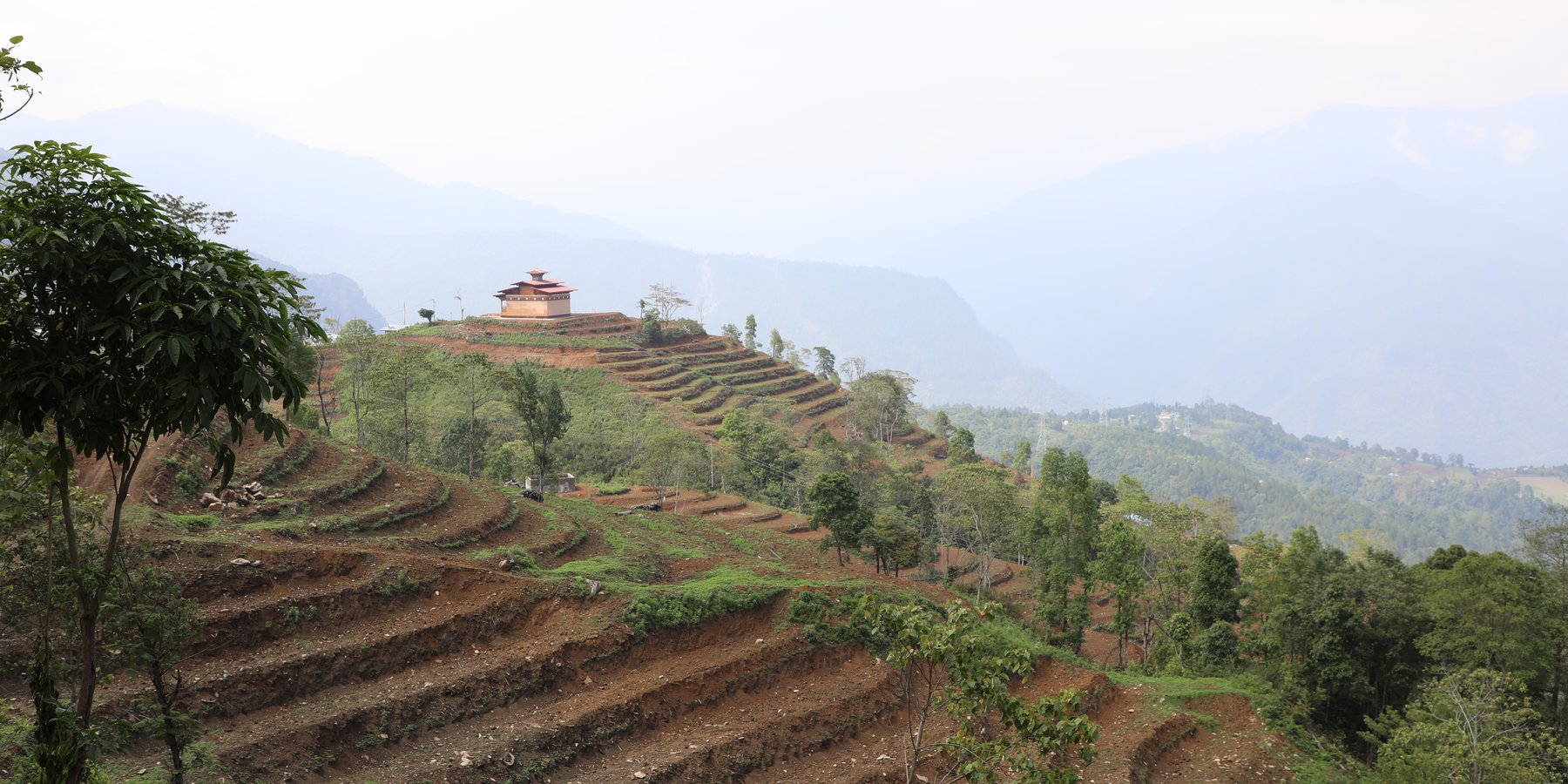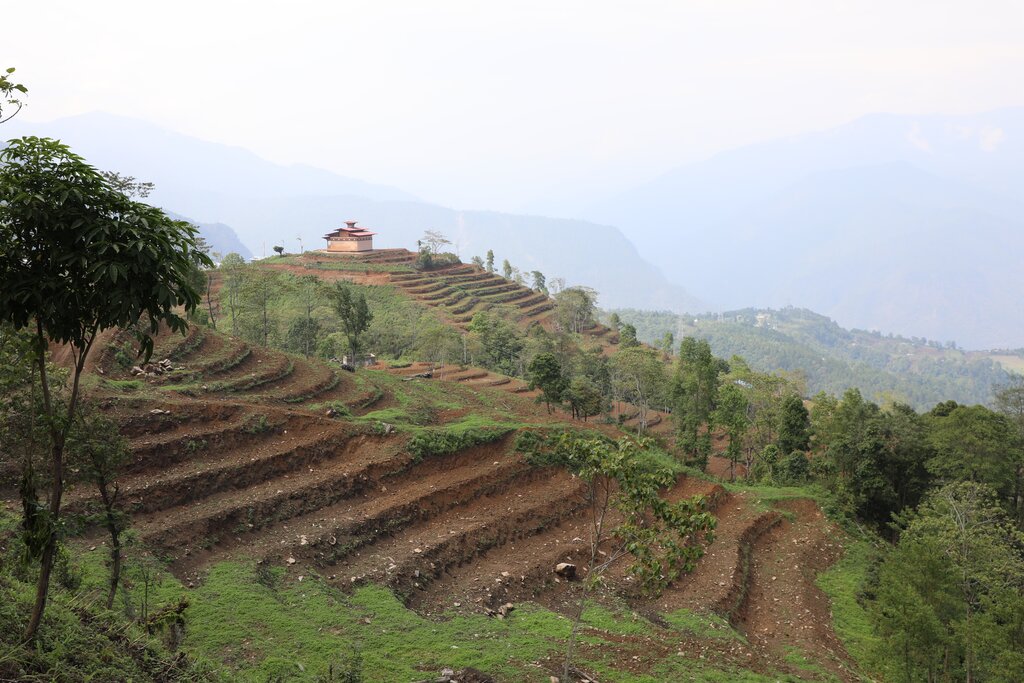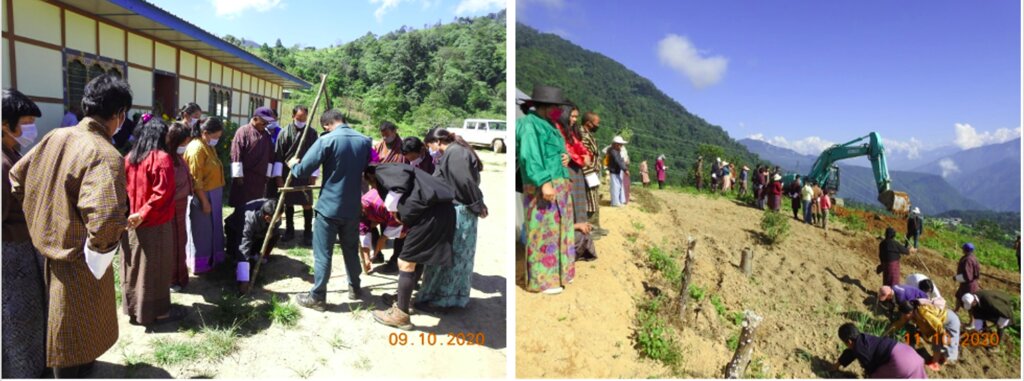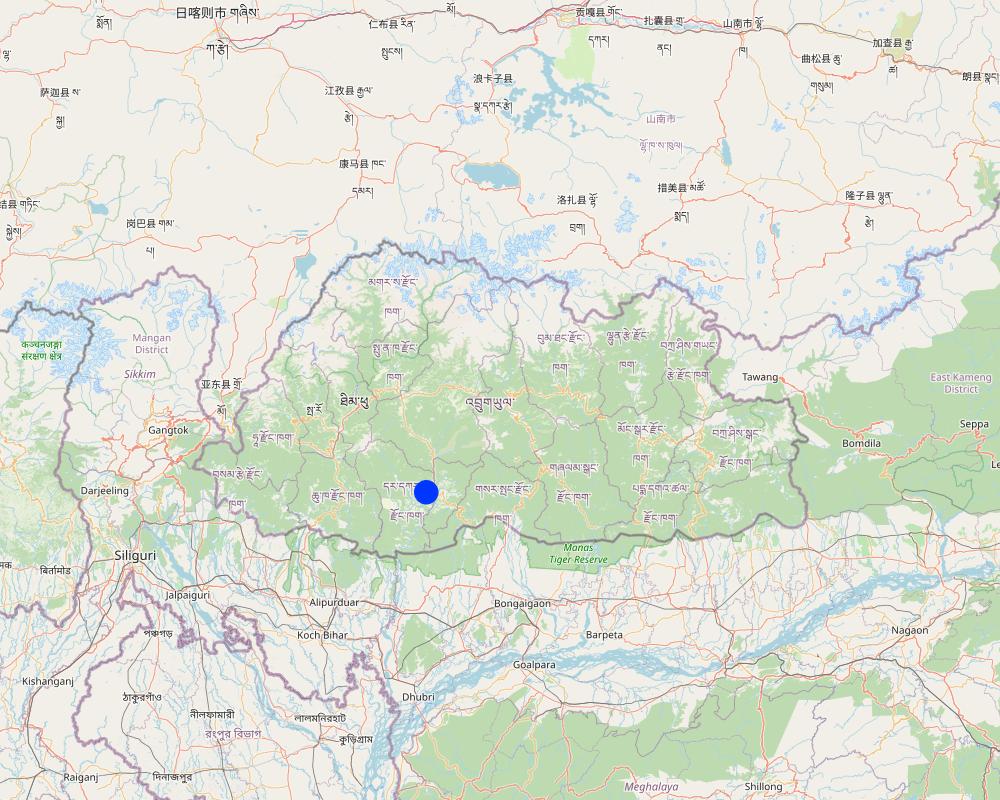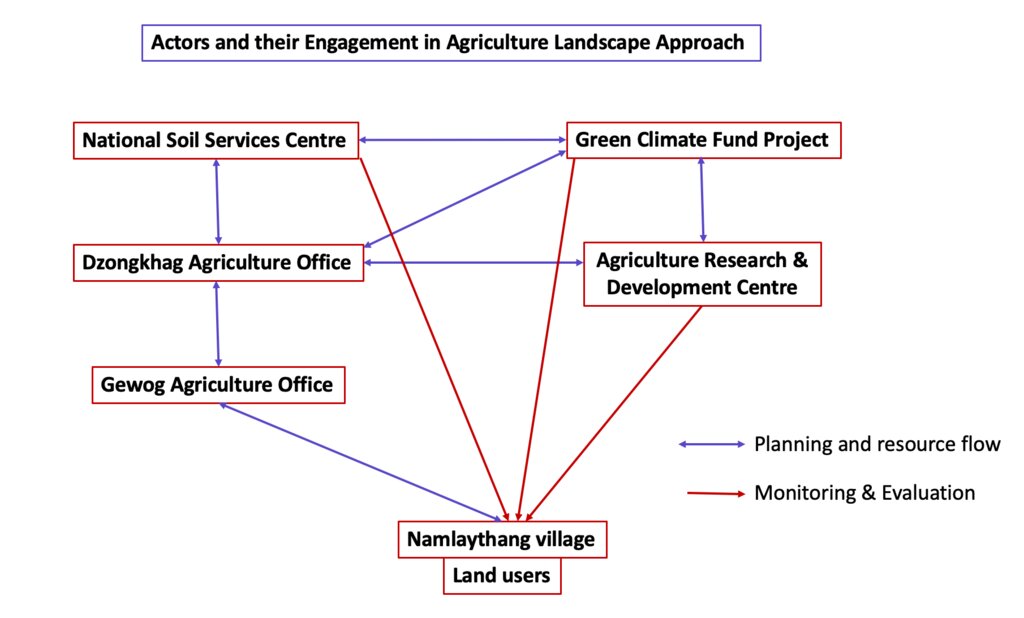Agricultural Landscape Approach for SLM Implementation [Bután]
- Creación:
- Actualización:
- Compilador: Nima Dolma Tamang
- Editor: Tashi Wangdi
- Revisores: William Critchley, Rima Mekdaschi Studer
སའི་ཆགས་ཐངས་དང་འཁྲིལ་ཡུན་བརྟན་ས་གཞི་འཛིན་སྐྱོང་ལག་ལེན་འཐབ་ཐངས།
approaches_6848 - Bután
Visualizar secciones
Expandir todo Colapsar todos1. Información general
1.2 Detalles de contacto de las personas de referencia e instituciones involucradas en la evaluación y la documentación del Enfoque
Persona(s) de referencia clave/s
Usuario de la tierra:
Dorji Damchoe
+97577463000
Namlaythang village, Tsangkha Gewog, Dagana Dzongkhag
Bután
Usuario de la tierra:
Tsagay
77438522
Namlaythang village, Tsangkha Gewog, Dagana Dzongkhag
Bután
Usuario de la tierra:
Dema Jigme
17405863
Namlaythang village, Tsangkha Gewog, Dagana Dzongkhag
Bután
Usuario de la tierra:
Wangda Yeshi
17888916
Namlaythang village, Tsangkha Gewog, Dagana Dzongkhag
Bután
Usuario de la tierra:
Norbu Nyagay
17504186
Namlaythang village, Tsangkha Gewog, Dagana Dzongkhag
Bután
Nombre del proyecto que facilitó la documentación/ evaluación del Enfoque (si fuera relevante)
Strengthening national-level institutional and professional capacities of country Parties towards enhanced UNCCD monitoring and reporting – GEF 7 EA Umbrella II (GEF 7 UNCCD Enabling Activities_Umbrella II)Nombre de la(s) institución(es) que facilitaron la documentación/ evaluación del Enfoque si fuera relevante)
National Soil Services Centre, Department of Agriculture, Ministry of Agriculture & Livestock (NSSC) - Bután1.3 Condiciones referidas al uso de datos documentados mediante WOCAT
¿Cuándo se compilaron los datos (en el campo)?
11/07/2023
El compilador y la/s persona(s) de referencia claves aceptan las condiciones acerca del uso de los datos documentados mediante WOCAT :
Sí
2. Descripción del Enfoque MST
2.1 Breve descripción del Enfoque
The Agricultural Landscape Approach in Sustainable Land Management is a holistic and integrated strategy that focuses on managing agricultural landscapes in a sustainable manner. The approach was successfully initiated in Namlaythang village and transformed the whole agricultural landscape covering 107 acres (43 ha) while benefitting 55 resettled households.
2.2 Descripción detallada del Enfoque MST
Descripción detallada del Enfoque MST:
The Agriculture Landscape Approach in Sustainable Land Management (SLM) is a holistic and integrated strategy that focuses on managing agricultural landscapes in a sustainable manner. This approach recognizes the interrelation of various elements within a landscape, including soil, water, biodiversity, and human activities, ultimately aiming to optimize the benefits derived from these interactions while minimizing negative environmental impacts.
This approach was initiated in Namlaythang village under Tsangkha gewog (block), Dagana Dzongkhag (district). Namlaythang was chosen for this approach because it is a new settlement with 55 resettled households who were granted land ranging from 1.75 to 3 acres (0.7 to 1.2 hectares) per family by His Majesty the King as per the National Rehabilitation Program. Since the area was recently cleared and converted to settlement and farming, there was a huge risk of land degradation due to direct exposure to rain and unsustainable agriculture practices. Therefore, it was not only timely to implement SLM to prevent land degradation but also appropriate to have adopted the Agricultural Landscape Approach by engaging the whole community.
The main aim of adopting the agricultural landscape approach was to bring transformational change at a scale. Too often, we plan and implement SLM interventions supported by different projects in small, localized areas and in a scattered manner. This limits the ability to scale out success (both spatially and temporally) despite being positive initiatives. The approach was also intended to facilitate a multi-stakeholder platform by bringing relevant stakeholders together to discuss common objectives and draw synergies across different agencies.
The process started by discussing the idea with the Dzongkhag and gewog agriculture offices followed by sensitization of land users on the importance of SLM and its technologies. This was followed by Participatory SLM Action planning wherein detailed action plans were prepared based on landowners’ interest, feasibility of their land and the available technologies. The next mandatory activity carried out before implementation of SLM in the field was the conduct of field based hands-on training of the land users. The main SLM technologies planned and implemented included terracing, stone bunds, hedgerows, check dams/ gully plugs and plantations. In addition, climate resilient agriculture practices were also promoted such as greenhouses, low-cost water harvesting ponds, drip irrigation sets and fruit tree plantations.
In promoting this approach and other technologies, several stakeholders were involved including the Dzongkhag and gewog agriculture offices, National Soil Services Center (NSSC), Agriculture Research and Development Center, Bajo (ARDC-Bajo), the landowners and a Green Climate Fund (GCF) Project. The agricultural offices provided the overall coordination and the facilitation role in implementing the approach and its associated technologies. The NSSC provided sensitization and training on SLM technologies and also facilitated participatory SLM Action Planning with the landowners and other stakeholders. Similarly, the ARDC-Bajo arranged material inputs for climate resilient agriculture practices and provided technical assistance to the landowners and the gewog agriculture extension officer. The GCF Project provided financial support based on the action plan.
The implementation of SLM and climate resilient agriculture practices following agricultural landscape approach in Namlaythang have been a great success. The approach has brought a transformational change at the landscape level through various SLM interventions which collectively contributed towards reduction of soil erosion and nutrient loss, conservation of soil moisture and the improvement of overall soil health and food security. The land users also feel empowered through sensitization, capacity building and their engagement in the whole process. In brief, the land users expressed their satisfaction with the approach and the impacts it has created in the agricultural landscape which is the basis of their livelihoods.
A major weakness of the approach is that there is no institution/group/cooperative formed for efficient coordination among the land users and other stakeholders which questions its sustainability.
2.3 Fotos del Enfoque
2.4 Videos del Enfoque
Fecha:
11/07/2023
Nombre del videógrafo:
Chimi Yangki
2.5 País/ región/ lugares donde el Enfoque fue aplicado
País:
Bután
Región/ Estado/ Provincia:
Dagana Dzongkhag
Especifique más el lugar :
Goongpa-Soomchu Chiwog, Tsangkha Gewog
Map
×2.6 Fechas de inicio y conclusión del Enfoque
Indique año del inicio:
2020
2.7 Tipo de Enfoque
- proyecto/ basado en un programa
2.8 Propósitos/ objetivos principales del Enfoque
To bring about transformational change through project intervention at the landscape level.
2.9 Condiciones que facilitan o impiden la implementación de la/s Tecnología/s aplicadas bajo el Enfoque
normas y valores sociales/ culturales/ religiosos
- facilitan
The strong community cooperation
disponibilidad/ acceso a recursos y servicios financieros
- facilitan
The SLM and climate resilient agriculture technologies were implemented with financial support provided by the government through a Green Climate Fund (GCF) project
entorno institucional
- facilitan
The land users implement a labour-sharing system where all the land users come together to work in the field and go to the next after completion of that field. They take turns to work in the field of all the land users.
colaboración/ coordinación de actores
- facilitan
All the relevant stakeholders (Dzongkhag, Gewog, Research, NSSC, Land owners) came together in implementing SLM and climate resilient agriculture practices
marco de trabajo legal (tenencia de tierra, derechos de uso de tierra y agua)
- facilitan
The land is granted by His Majesty the King to the landless families under Land Use Certificate (LUC), where the land users have the right to settle, cultivate and make a living from the land, but do not have right to sell their land.
políticas
- facilitan
National Food and Nutrition Security 2022
Bhutan Water Policy 2007
gobernanza de tierras (toma de decisiones, implementación y aplicación)
- facilitan
The land users with land use right only. The land users can cultivate different crops on the land by implementing SLM technologies.
conocimiento de MST, acceso a apoyo técnico
- facilitan
Technical support was provided by the Gewog Agriculture Extension Officer, Agriculture Research Development Centre (ARDC) and NSSC. Moreover, there is a willingness of the farmers to gain more knowledge and experience.
mercados (para comprar insumos, vender productos) y precios
- facilitan
The village is well connected by the newly constructed farm road. All the farm produces can be marketed locally or can be taken to other markets
carga de trabajo, disponibilidad de mano de obra
- impiden
Since most of the children were enrolled in schools, farm labour shortage is of major concern.
3. Participación y roles de las partes interesadas involucradas
3.1 Partes interesadas involucradas en el Enfoque y sus roles
- usuarios locales de tierras/ comunidades locales
Land owners
Attend sensitization and training program on SLM technologies and implement in the field.
- especialistas MST/consejeros agrícolas
National Soil Services Center (NSSC)
NSSC provided training, sensitization and demonstration on SLM technologies to the land owners
- investigadores
Agriculture Research and Development Centre (ARDC)
ARDC provided material inputs and technical assistance in implementing Climate Resilient Agriculture Practices in the field.
- gobierno local
Dzongkhag and gewog agriculture offices
The Dzongkhag and gewog agriculture offices arranged financial and technical assistance in implementing SLM and Climate Resilient Agriculture Practices in the field while also coordinating and facilitating the whole implementation process.
- organización internacional
United Nations Development Programme (UNDP)
Provided financial support through a Green Climate Fund (GCF) Project
3.2 Involucramiento de los usuarios locales de tierras/ comunidades locales en las distintas fases del Enfoque
| Involucramiento de los usuarios locales de tierras/ comunidades locales | Especifique quién se involucró y describa las actividades | |
|---|---|---|
| iniciación/ motivación | interactivo | The land owners actively participate in the initial discussion on the SLM implementation following landscape approach. The process was facilitaed by the local government officials. |
| planificación | interactivo | The land onwers and the local elected leaders were involved in the participatory SLM action planning that was facilitated jointly by the Dzongkhag and the NSSC. |
| implementación | auto-movilización | Land owners organized themselves into informal groups to implement SLM interventions with technical assistance from the Dzongkhag, gewog and ARDC. |
| monitoreo y evaluación | interactivo | Land owners were involved in the periodic monitoring and evaluation carried out jointly by the Dzongkhag, gewog, NSSC, ARDC and the GCF project. |
3.3 Flujograma (si estuviera disponible)
Descripción:
This Flow chart shows the actors and their involvement in implementing Agricultural Landscape Approach in Namlaythang. It clearly shows that for planning and resource mobilization, other actors including the National Soil Services Centre, Green Climate Fund Project and the Agriculture Research and Development Centre worked through the Dzongkhag and Gewog Agriculture Offices. But for monitoring and evaluation, those actors can come directly to the field and carry out monitoring and evaluation without necessarily engaging the Dzongkhag and Gewog Agriculture Offices. However, if there is a need, they can inform and invite Dzongkhag and Gewog Agriculture Officials.
Autor:
Tashi Wangdi
3.4 La toma de decisiones en la selección de Tecnología(s) MST
Especifique quién decidió la selección de las Tecnología/ Tecnologías a implementarse:
- todos los actores relevantes, como parte de un enfoque participativo
Explique:
Following the sensitization on SLM technologies, Participatory SLM Action Planning was carried out wherein the land owners, gewog agriculture extension and the SLM Specialists from NSSC jointly select and decide on SLM technologies to be implemented in the field.
- The decision was made based on the sensitization and the feasibility of the farming landscape.
4. Apoyo técnico, fortalecimiento institucional y gestión del conocimiento
4.1 Construcción de capacidades / capacitación
¿Se proporcionó la capacitación a usuarios de tierras/ otras partes interesadas?
Sí
Especifique quién fue capacitado:
- usuarios de tierras
Si fuese relevante, también especifique género, edad, estatus, etnicidad, etc.
Gender equity is generally maintained by inviting equal number of male and female participants and of different age groups.
Forma de capacitación:
- áreas de demostración
Temas avanzados:
SLM Technologies (Terracing, hedgerows, stone bunds, plantations and check dams)
Comentarios:
The training was field based and practical oriented.
4.2 Servicio de asesoría
¿Los usuarios de tierras tienen acceso a un servicio de asesoría?
Sí
Especifique si servicio proporcionado se realizó:
- en los campos de los usuarios de tierras
Describa/ comentarios:
Advisory services were provided by the agriculture advisers from the Dzongkhag and Gewog Agriculture offices.
4.3 Fortalecimiento institucional (desarrollo institucional)
¿Se establecieron o fortalecieron instituciones mediante el Enfoque?
- sí, mucho
Especifique el nivel o los niveles en los que se fortalecieron o establecieron las instituciones:
- local
- regional
- nacional
Describa la institución, roles y responsabilidades, miembros, etc.
There is no new institution established within the approach. However, various institutions were involved in promoting the technologies under the approach. At the local level, Dzongkhag and Gewog agriculture offices were involved in overall coordination and provided technical guidance. The Dzongkhag agriculture offices were also involved in sourcing funds for the implementation of the approach. Regional Agriculture Research and Development Center, Bajo (ARDC-Bajo) arranged material inputs for climate-resilient agriculture practices and provided technical assistance to the gewog agriculture extension officer and land owners. National Soil Service Center (NSSC) provided sensitization and training on SLM technologies and also facilitated participatory SLM Action Planning with the land owners and other stakeholders. The Green Climate Fund (GCF) Project was the main funding agency providing financial support based on the action plan.
Especifique el tipo de apoyo:
- financiero
- construcción de capacidades/ entrenamiento
- equipo
Proporcione detalles adicionales:
The major financial support was provided by the GCF project and minor fund support was provided by the government for the implementation of the approach. Various stakeholders including NSSC, ARDC-Bajo, Dzongkhag and gewog offices were involved in the capacity building of the land owners. However, gewog offices were involved constantly due to the proximity and direct contact with the land owners. Equipment for the construction of greenhouses, low-cost water harvesting ponds, drip irrigation, terracing, stone bunds, hedgerows and check dams were provided during the implementation of technologies under the approach.
4.4 Monitoreo y evaluación
¿El monitoreo y la evaluación forman parte del Enfoque?
Sí
Comentarios:
The monitoring and evaluation are periodically done by the Dzongkhag Agriculture Office, NSSC and the Project Management Unit of the GCF Project.
Si respondió que sí, ¿la documentación se utilizará para monitoreo y evaluación?
Sí
Comentarios:
The documentation is intended to be used for monitoring and evaluation and also for knowledge sharing.
4.5 Investigación
¿La investigación formó parte del Enfoque?
No
5. Financiamiento y apoyo material externo
5.1 Presupuesto anual para el componente MST del Enfoque
Si no se conoce el presupuesto anual preciso, indique el rango:
- 10,000-100,000
Comentarios (ej. fuentes principales de financiamiento/ donantes principales):
The main funding source is GCF project
5.2 Apoyo financiero/material proporcionado a los usuarios de tierras
¿Los usuarios de tierras recibieron financiamiento/ apoyo material para implementar la Tecnología/ Tecnologías? :
Sí
Si respondió sí, especifique el tipo o los tipos de apoyo, condiciones y proveedor(es) :
The implementation of all the SLM technologies was funded by the GCF project. Besides, land owners also received material supports such as greenhouses, low cost water harvesting ponds, drip irrigation sets, seeds and seedlings with financial support from the project and government.
5.3 Subsidios para insumos específicos (incluyendo mano de obra)
- agrícola
| Especifique qué insumos se subsidiaron | En qué grado | Especifique los subsidios |
|---|---|---|
| semillas | totalmente financiado | Vegetable seeds |
- construcción
| Especifique qué insumos se subsidiaron | En qué grado | Especifique los subsidios |
|---|---|---|
| piedra | totalmente financiado | For stone check dam construction in the gullies |
| madera | totalmente financiado | For log check dam construction in the gullies |
- infraestructura
| Especifique qué insumos se subsidiaron | En qué grado | Especifique los subsidios |
|---|---|---|
| Greenhouse | totalmente financiado | Prefabricated Greenhouse sets |
Si la mano de obra de usuarios de tierras fue un insumo sustancial, ¿fue:
- voluntario?
Comentarios:
Land owners usually arrange their own family labour or through labour exchange to implement SLM technologies in the field.
5.4 Crédito
¿Se proporcionó crédito bajo el Enfoque para actividades MST?
No
5.5 Otros incentivos o instrumentos
¿Se usaron otros incentivos o instrumentos para promover la implementación de Tecnologías MST?
Sí
Si fuera el caso, especifique :
The SLM Technologies and Climate Resilient Agriculture practices were provided in line with the SLM Guidelines and Best Practices 2021 and the Cost Sharing Mechanisms of the Ministry of Agriculture and Livestock.
6. Análisis de impacto y comentarios de conclusión
6.1 Impactos del Enfoque
¿El Enfoque empoderó a los usuarios locales de tierras, mejoró el involucramiento de las partes interesadas?
- No
- Sí, un poco
- Sí, moderadamente
- Sí, mucho
The approach empowered local land users through capacity building and self-mobilization in implementing SLM technologies in the field.
¿El Enfoque ayudó a los usuarios de tierras a implementar y mantener Tecnologías MST?
- No
- Sí, un poco
- Sí, moderadamente
- Sí, mucho
The landscape approach encouraged all the land owners to participate and implement SLM Technologies.
¿El Enfoque mejoró la coordinación e implementación efectiva en costos de MST?
- No
- Sí, un poco
- Sí, moderadamente
- Sí, mucho
The landscape approach enabled stakeholders to converge and coordinate better planning and implementation by avoiding duplication and harnessing synergy and complimentary effects.
The landscape approach was used in accessing financial support from the GCF Project.
¿El Enfoque mejoró el conocimiento y capacidades de los usuarios para implementar MST?
- No
- Sí, un poco
- Sí, moderadamente
- Sí, mucho
The training and technical support were provided to the land users improving their knowledge and skills to implement SLM technologies.
¿El Enfoque construyó/ fortaleció instituciones, colaboración entre partes interesadas?
- No
- Sí, un poco
- Sí, moderadamente
- Sí, mucho
The landscape approach greatly enhanced collaboration between the existing stakeholders as it brought all the relevant stakeholders together to improve the land on which people depend for their livelihoods. For example, the gewog extension officers were trained by NSSC and ARDC-Bajo to disseminate technical information to the land users. However, there is no institution/group formed as part of the approach through which land users communicate within themselves or with other stakeholders to maintain or improve the technologies under the approach.
¿El Enfoque resultó en mejor seguridad alimentaria/ mejoró la nutrición?
- No
- Sí, un poco
- Sí, moderadamente
- Sí, mucho
Through this approach different SLM and Climate Resilient Agriculture practices were implemented which ensures better soil health, better soil productivity and improved food security.
¿El Enfoque llevó a un acceso mejorado a tierra y saneamiento?
- No
- Sí, un poco
- Sí, moderadamente
- Sí, mucho
Through this approach, certain supports were given to improve access and better utilization of water resource.
¿El Enfoque mejoró la capacidad de los usuarios de tierras a adaptarse a los cambios climáticos/ extemos y mitigar desastres relacionados al clima?
- No
- Sí, un poco
- Sí, moderadamente
- Sí, mucho
The landscape approach did improve the capacity of the land users through training and their active participation in the implementation of SLM technologies in the field.
¿El Enfoque llevó a oportunidades de empleo, ingresos?
- No
- Sí, un poco
- Sí, moderadamente
- Sí, mucho
The landscape approach did contribute moderately to employment and income opportunities as some of the SLM technologies encouraged land owners to work their land and produce more for cash income.
6.2 Motivación principal del usuario de la tierra para implementar MST
- producción incrementada
The land is the basis of food production. So any improvement in land will contribute towards better production.
- incremento de la renta(bilidad), proporción mejorada de costo-beneficio
The land is a main source of livelihood for the land users and a source of income. Therefore, taking care of the land to prevent erosion and ease farming is one of the main priorities.
- reducción de la degradación de la tierra
Reducing land degradation is the main motivation of the land users as their land which was under forest cover was recently cleared and allocated to the land users for agricultural use. Thus the risk of surface erosion and landslides is high as the land surface is exposed directly to sun and rain. Therefore, the implementation of SLM technologies such as terracing, hedgerows, stone bunds and check dams help reduce soil erosion and landslides.
- reducción del riesgo de desastres naturales
Implementation of SLM technologies reduces the vulnerability of the land to disasters such as landslides and erosion.
- conocimiento y capacidades mejorados de MST
The land owners were sensitized, trained and actively involved in the implementation of SLM Technologies.
- mejoramiento estético
Physical land terracing improves aestheic value and look of the agricultural landscape.
6.3 Sostenibilidad de las actividades del Enfoque
¿Pueden los usuarios de tierras sostener lo que se implementó mediante el Enfoque (sin apoyo externo)?
- sí
Si respondió que sí, describa cómo:
Based on the experience that land users have gained over the past 5 years, the land owners can sustain the technology implemented through this approach without external support as the maintenance cost is very minimal. The land owners feel that they can carry out maintenance on their own.
6.4 Fortalezas/ ventajas del Enfoque
| Fuerzas/ ventajas/ oportunidades desde la perspectiva del usuario de la tierra |
|---|
| The community has not experienced any reported problems related to landslides, indicating the positive impact of terracing and check dams that have ensured the overall stability and sustainability of the area. |
| The land users can make a living from increased agricultural production and cash income. |
| Since the land was granted by His Majesty the King, the community receives so much of attention and technical support from different agencies. This has enabled the land users to avail much needed SLM interventions through the landscape approach. |
| Fuerzas/ ventajas/ oportunidades desde la perspectiva del compilador o de otra persona de referencia clave |
|---|
| The land users are exposed to new knowledge and skills to implement SLM technologies, which could serve as a model for further replication in other areas. |
| There is a transformational change at the landscape level, which otherwise becomes difficult if landscape approach was not adopted. |
6.5 Debilidades/ desventajas del Enfoque y formas de sobreponerse a ellos
| Debilidades/ desventajas/ riesgos desde la perspectiva del usuario de la tierra | ¿Cómo sobreponerse a ellas? |
|---|---|
| No institution/group/cooperative has been formed for efficient coordination among the land users. | By forming a permanent or formal group to continue the implementation and management of the SLM technologies. |
| Limited integration of livestock and forest related technologies due to limited fund. | Explore additional funding source from other sources such as Bhutan Trust Fund for Environmental Conservation (BTFEC) and UNDP Small Grant Project (SGP) to support implementation of livestock and forestry activities. |
| Debilidades/ desventajas/ riesgos desde la perspectiva del compilador o de otra persona de referencia clave | ¿Cómo sobreponerse a ellas? |
|---|---|
| No lead agency or personnel to initiate group formation. | The Gewog Agriculture Extension Officer could lead the group formation if they feel the need. |
| Lack of frequent monitoring of the implemented SLM technologies leading to reduced performance in terms of agriculture production and maintenance of the SLM technologies. | Ensure timely monotiring from the Gewog and Dzongkhag Agriculture offices |
7. Referencias y vínculos
7.1 Métodos/ fuentes de información
- visitas de campo, encuestas de campo
Five
- entrevistas con usuarios de tierras
Five
7.2 Referencias a publicaciones disponibles
Título, autor, año, ISBN:
Sustainable Land Management (SLM) Guidelines and Best Practices 2021, The National Soil Services Center, Department of Agriculture, Ministry of Agricultue and Livestock
¿Dónde se halla disponible? ¿Costo?
The National Soil Services Center, Semtokha, Thimphu, Bhutan
7.3 Vínculos a la información relevante disponible en línea
Título/ descripción:
Zhesar namleythang
URL:
https://www.facebook.com/people/Zhesar-namleythang/100063962648613/?paipv=0&eav=AfZtqSeoJRJKQqV2pCQNI-Il9HsLY_XP-7nuLPGmeGHxTe7zq2FNEBbJReJwVuGjErk&_rdr
Vínculos y módulos
Expandir todo Colapsar todosVínculos
No hay vínculos
Módulos
No se hallaron módulos


